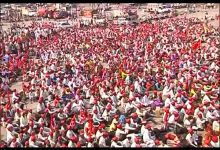The Congress President Rahul Gandhi has been acting as the unifier of the anti-BJP forces giving up the arrogance associated with the grand old party that it is the natural party of governance. Karnataka assembly elections results set the process and frankly speaking, the emergence of the BJP as the single largest party in Karnataka assembly bringing down the Congress strength from 122 to 78, was a blessing for the opposition unity. A political analysis, for Different Truths.
At long last, the Congress President Rahul Gandhi has been acting as the unifier of the anti-BJP forces giving up the arrogance associated with the grand old party that it is the natural party of governance. Karnataka assembly elections results set the process and frankly speaking, the emergence of the BJP as the single largest party in Karnataka assembly bringing down the Congress strength from 122 to 78, was a blessing for the opposition unity. If the Congress would have got majority like the 2013 elections, the party would have remained arrogant like before and the Congress President would not have opted for all-out efforts to build a unity of the anti-BJP parties even including the smaller ones.
What is most positive about the opposition prospects is that the Congress took the initiative to persuade the JD(S) to agree to the strategy of a pre-poll alliance against the BJP in the coming Lok Sabha poll and further, soon after the Kairana and the other by poll results were out, Rahul Gandhi gave green signal to the Madhya Pradesh Congress President Kamal Nath to have discussions with the BSP leader for an alliance for the coming assembly elections. Rahul is now of the view that all efforts will have to be made to minimize the division of anti-BJP votes and only through this, the saffrons can be kept out of power at the centre after the next Lok Sabha elections.
In fact, Rahul Gandhi is now fully following what the West Bengal Chief Minister Mamata Banerjee has been saying publicly for the last six months. Mamata has strong political sense and on the eve of Karnataka assembly elections, she said that only a pre-poll alliance between the Congress and the JD(S) can defeat the BJP. But when the alliance did not take place due to Congress complacency, she said that even then the BJP might not form the government, the JD(S) leader H D Kumaraswamy might emerge as the coalition chief minister. She has also been maintaining that the BJP got majority seats in 2014 Lok Sabha elections by getting only 31 percent of the votes and by preventing the division of anti-BJP votes, the opposition parties might unseat BJP in the next elections.
Rahul Gandhi, it seems, is now convinced of Mamata’s strategy. Not only the Congress is talking to BSP for an alliance in MP, Rajasthan, and Chhattisgarh, the Congress president is scheduled to have a meeting with the BSP chief Mayawati and the Samajwadi Party President Akhilesh Yadav shortly to discuss overall alliance of the three parties to fight the BJP at the national level. If a perfect understanding is arrived at, that will make a sea change in the opposition mood which is already buoyant after the latest by poll results.
Right now, the assembly elections in the three states MP, Rajasthan, and Chhattisgarh by year end are crucial as those are the only important elections before the scheduled general elections. In all the three states, BSP has been getting a poll percentage of 6 to 7 percent by fighting alone. If this is added to the Congress votes, there are the possibilities for the Congress victory in all the three states as the anti-incumbency is very high in these BJP ruled states and the signs were very much there in the by elections held earlier this year in both MP and Rajasthan. In fact, this alliance can be expanded by associating the left parties the CPI and the CPI(M) which have pockets of influence in those three states and those votes are of crucial importance to defeat BJP in marginal seats.
The opposition parties, including the Congress, have to be prepared for a flexible strategy on unity against the BJP taking into account the presence of regional parties which are also arrayed against the BJP, but will not give space to the Congress. This is relevant to the southern states of Andhra Pradesh and Telangana. Both Telegu Dasam and Telangana Rashtriya Samiti are now against the BJP but they will not allow the Congress to gain in their states. In these states, the only understanding can be an agreement on a few seats where the BJP is strongest and the saffrons can be defeated by a sort of local alliance. In Tamil Nadu, the DMK is the leader of the opposition alliance and M K Staling will decide on the front strategy. In Kerala, the Congress and the Left Front will be fighting and whoever wins, will contribute to the anti-BJP front.
The Congress has to expand its alliance in Maharashtra apart from NCP. There are some small parties with limited bases and also the left parties have pockets of influence. An overall understanding can be worked out to fight the BJP in Maharashtra and the opposition should gain heavily in this western state as the Shiv Sena is supposed to fight separately in the coming Lok Sabha poll. In the context of anti-BJP mood, the expanded Congress-NCP alliance should do extremely well in Maharashtra in 2019 poll. The Congress can have an understanding with the BSP and other small parties in Gujarat to bring down the seats of the BJP significantly and that is quite possible in the present political situation in Gujarat.
The Congress has to redraw it strategy in the North Eastern states by bringing in the fold of its alliance the regional parties which have been taken away by the BJP through coercion by making use of its power at the centre.BJP is not the accepted party to the NE people. The present phase is temporary. The Congress leadership has to be innovative and appeal to the local parties for being a part of the secular alliance. The BJP is depending on its performace in NE states to increase its tally. The Congress has to combat it with the right programmes.
In eastern India, in Bengal, Mamata will continue to remain supreme by maintaining or even improving its present strength of 34 out of the total of 42 seats. In Bihar, the RJD is the leading force of the opposition and it is on the move. The RJD-Congress alliance should be expanded by splitting the JD(U) and bringing within the purview the left parties like CPI, CPI(M) and the CPI(ML). The inclusion of the Left, especially the CPI and the CPI(ML) will give a big boost to the opposition alliance. In Odisha, the BJD will remain the driving force against the BJP. It will be difficult for the BJD leader Naveen Patnauik to give space to the Congress against the BJP. The only possibility is to ensure that in a few seats with strong BJP presence, the BJP and the other anti-BJP parties like the Congress cooperate to prevent a division of anti-BJP votes.
The path of opposition unity for 2019 Lok Sabha elections is quite tortured and not at all smooth, but the ground is favourable and even if there is a common understanding in 60 per cent of the Lok Sabha seats, that will be adequate to bring the BJP strength down to less than 150 seats. This should be the normal strength of the saffrons. The 2014 figure of 282 was due to an abnormal political situation. Fortunately for the country, that situation is no more there, the ground is fertile and it depends on the opposition parties to take advantage of that without making any big mess in the next ten months.
Nitya Chakraborty
©IPA service
Photo from the Internet





 By
By
 By
By

 By
By